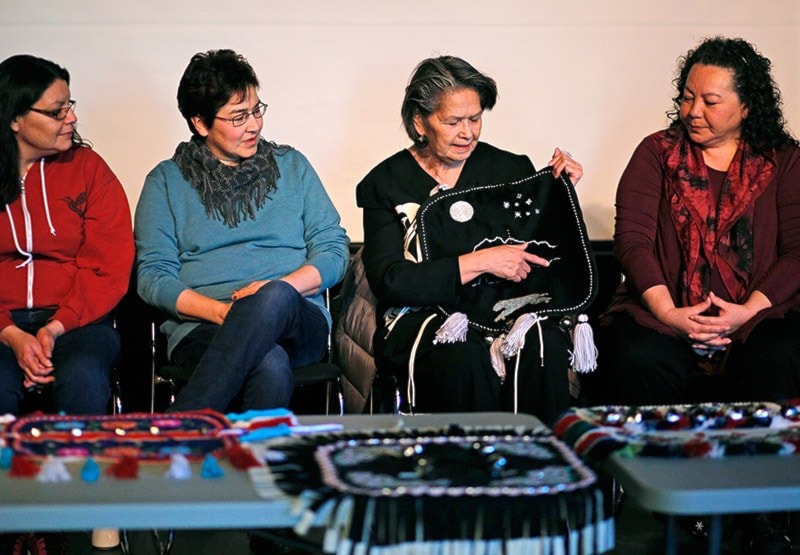When musher Armin Johnson leaves the Yukon Quest chute during the ceremonial start Feb. 4, look at his dogs.
In particular, look at what his nine dogs will be wearing: traditional handcrafted dog blankets.
Nine Yukon women spent months working on the blankets, a time-honoured tradition among First Nations that is now hard to find.
“It’s to honour the athletes in the race,” said Shirley Adamson, an elder and one of the women who made blankets.
“The dogs are the athletes, the mushers are their assistant to get from here to there.”
After months of work, the women, who are part of the Kwanlin Dun Cultural Centre’s sewing group, showcased their work Jan. 30 during a public event.
Some went for more traditional patterns, with glass beads and embroidery, others blended the traditional with more modern patterns, for example replicating the territory’s crest.
Some blankets feature dozen of embroidered flowers, others have multiple stitched outlines with beads — but each required hundreds of hours of work.
Adamson stitched the itinerary of the trail, using glass beads of different colours to represent the dog drops and mandatory layovers. Below the trail itinerary she stitched the elevation of the trail.
Her blanket also features a dog running under the moon and the stars.
Because of the importance of oral history among Yukon First Nations, clothing, including blankets, was often used to transmit stories.
“We come from a society that didn’t have a written language until quite recently,” Adamson said. “That’s how we told our stories, through our crests and moccasins and clothing designs.”
And the blankets represented an occasion for mushers to display where they were from.
“When we were growing up we wouldn’t put blankets on our dogs until the end because it was a decorative thing and it showed where we came from,” Adamson said.
For Adamson there’s a particular meaning to making a dog blanket for the Yukon Quest. Her father is from Alaska, her mother is from the Yukon.
“I feel a bit more of an ownership to running from the Yukon to Alaska,” she said.
Traditionally the blankets were made from recycled and leftover materials, back when fabric and modern textiles weren’t widely available.
The Yukon Quest blankets are made from canvas, and some have velveteen and melton wool.
Most of the blankets have tassels and bells, making for a very recognizable sound anytime a mushing team used to come by.
“There was nothing more exciting than to hear the dogs coming in with the bells,” Adamson said.
For Nyla Klugie-Migwans, making the blankets is also a way to retain traditional knowledge for the next generation.
“If we don’t start to teach the young people about what our culture is and what the meaning is, the younger generation is not going to understand the importance of why we made certain things for our families,” she said.
She spoke to the importance of respecting the dogs, and animals in general.
“We need to go back to that basic knowledge to what is it to respect the animal,” she said. “We’re able to show people that animals must be respected, always.”
That respect came from the fact that dogs were crucial for a family’s survival, helping with hunting, trapping and fishing. They were honoured as workers, Adamson said.
“The value of a dog (back then) is much more different than one that just sits at the fireplace being a pet,” she said.
Florence Moses, who got the group together to work on the Quest blankets, told the audience the group would be making an application to the Yukon Permanent Art Collection. The government could decide to buy the blankets for the collection — but ultimately the decision to part with their blankets will rest with each of the women.
Contact Pierre Chauvin at pierre.chauvin@yukon-news.com
